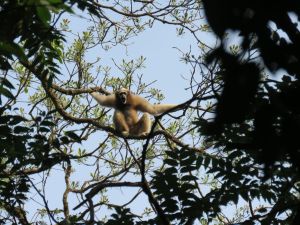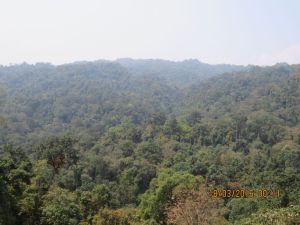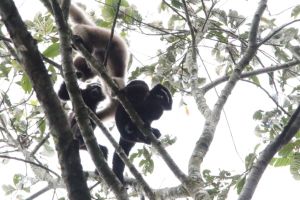Difference between revisions of "Hukaung Valley Wildlife Sanctuary"
(Created page with "<!-- INSTRUCTIONS FOR UPLOADING SITE INFORMATION - Wiki pages contain information in paragraphs, tables, lists, and images. - Text and images are not restricted, and their for...") |
(No difference)
|
Revision as of 10:55, 16 November 2023
Asia > Myanmar > Hukaung Valley Wildlife Sanctuary
Summary
- Eastern Hoolock Gibbons (Hoolock leuconedys) and Western Hoolock Gibbons (Hoolock hoolock) are present in Hukaung Valley Wildlife Sanctuary .
- The population size is unknown.
- The gibbon population trend is stable.
- The site has a total size of 21,802 km².
- Gibbons are mainly threatened by commercial hunting.
- Conservation activities include biomonitoring, patrolling, and environmental education.
Site characteristics
Hukaung Valley Wildlife Sanctuary (HVWS), also known as Hukaung Tiger Reserve, is located in northwestern Myanmar. The site was established in 2001 and is currently in the tentative list for becoming a UNESCO World Heritage site. Due to its large size, connection to other protected areas, and diversity of forest types and elevations, HVWS contains a diverse assemblage of wildlife. HVWS includes many threatened and wide-ranging species such as the Asian Elephant, Tiger, and Rufous-necked Hornbill. The Hoolock Gibbon and Shortridge’s Langur are also present (UNESCO 2014).
Table 1. Basic site information for Hukaung Valley Wildlife Sanctuary
| Area | 21802.53 km² |
| Coordinates | 26.168635, 95.986726 |
| Designation | Wildlife Sanctuary |
| Habitat types | Subtropical/tropical moist lowland forest, grassland |
IUCN habitat categories Site designations
Ape status
Table 2. Ape population estimates in Hukaung Valley Wildlife Sanctuary
| Species | Year | Total number indiv. (95% CI) | Total number groups (95% CI) | Density [groups/km²] (95% CI) | Area | Method | Source | Comments | A.P.E.S. database ID |
|---|---|---|---|---|---|---|---|---|---|
| Hoolock leucodenys | 2005-2006 | 2.81 | Hukaung Valley Wildlife Sanctuary | Auditory Survey Method | Htun et al. 2006 | ||||
| Hoolock leuconedys & Hoolock hoolock | 2016 | present | Hukaung Valley Wildlife Sanctuary | Photo Taking and Direct Counting | NWCD/WCS 2016 | Gibbon Face photo taking and collect faecal for DNA Analysis |
Threats
Table 3. Threats to apes in Hukaung Valley Wildlife Sanctuary
| Category | Specific threats | Threat level | Quantified severity | Description | Year of threat |
|---|---|---|---|---|---|
| 1. Residential & commercial development | Unknown | ||||
| 2. Agriculture & aquaculture | Unknown | ||||
| 3. Energy production & mining | 3.2 Mining & quarrying | Present (unknown severity) | (Ko Aung Ye Tun pers. obs. 2023) | Ongoing (2023) | |
| 4. Transportation & service corridors | Unknown | ||||
| 5. Biological resource use | 5.1 Hunting & collecting terrestrial animals | Present (unknown severity) | (Ko Aung Ye Tun pers. obs. 2023) | Ongoing (2023) | |
| 5. Biological resource use | 5.2 Gathering terrestrial plants | Present (unknown severity) | (Ko Aung Ye Tun pers. obs. 2023) | Ongoing (2023) | |
| 5.3 Logging & wood harvesting | Present (unknown severity) | (Ko Aung Ye Tun pers. obs. 2023) | Ongoing (2023) | ||
| 6. Human intrusion & disturbance | Unknown | ||||
| 7. Natural system modifications | Unknown | ||||
| 8. Invasive & other problematic species, genes, diseases | Unknown | ||||
| 9. Pollution | Unknown | ||||
| 10. Geological Events | Absent | ||||
| 11. Climate change & severe weather | 11.1 Habitat shifting & alteration | Present (unknown severity) | (Ko Aung Ye Tun pers. obs. 2023) | Ongoing (2023) | |
| 12. Other options | Absent |
Conservation activities
WCS established an Eastern Hoolock gibbon conservation project for population monitoring and community outreach at a number of protected areas, including Hukaung Valley Wildlife Sanctuary (Thompson et al. 2023).
Table 4. Conservation activities in Hukaung Valley Wildlife Sanctuary
| Category | Specific activity | Description | Year of activity |
|---|---|---|---|
| 1. Residential & commercial development | Not reported | ||
| 2. Agriculture & aquaculture | Not reported | ||
| 3. Energy production & mining | Not reported | ||
| 4. Transportation & service corridors | Not reported | ||
| 5. Biological resource use | 5.15. Implement monitoring surveillance strategies (e.g. SMART) or use monitoring data to improve effectiveness of wildlife law enforcement patrols | (Ko Aung Ye Tun pers. comm. 2023, Thompson et al. 2023) | 2019-Ongoing (2023) |
| 5.16. Implement community control of patrolling, banning hunting and removing snares | (Ko Aung Ye Tun pers. comm. 2023) | Ongoing (2023) | |
| 6. Human intrusion & disturbance | Not reported | ||
| 7. Natural system modifications | Not reported | ||
| 8. Invasive & other problematic species, genes, diseases | Not reported | ||
| 9. Pollution | Not reported | ||
| 10. Education & Awareness | 10.1. Educate local communities about primates and sustainable use | (Ko Aung Ye Tun pers. comm. 2023) | Ongoing (2023) |
| 11. Habitat Protection | 11.2. Legally protect primate habitat | The site is a protected area. | 2001-Ongoing (2023) |
| 12. Species Management | Not reported | ||
| 13. Livelihood; Economic & Other Incentives | 13.5. Permanent presence of staff/manager | (Ko Aung Ye Tun pers. obs. 2023) | Ongoing (2023) |
Conservation activities list (Junker et al. 2017)
Challenges
Challenges to the implementation of conservation activities include armed conflict and limited financial resources, as well as the challenge of protecting such a huge area (Ko Aung Ye Tun pers. obs. 2023).
Table 5. Challenges reported for Hukaung Valley Wildlife Sanctuary
| Challenge | Source |
|---|---|
| Civil unrest | Ko Aung Ye Tun pers. obs. 2023 |
| Lack of financial means | Ko Aung Ye Tun pers. obs. 2023 |
Research activities
Documented behaviours
Table 6. Ape behaviors reported for Hukaung Valley Wildlife Sanctuary
| Behavior | Source |
|---|---|
| Not reported |
External links
References
Htun, S., Aung, Z. H., Naing, W., Khaing, Z. W., Htay, T., Tun, N. L., ... & Moe, T. K. (2006). Final Report on conservation of the hoolock gibbon (Hylobates hoolock) in the Hukaung Tiger Reserve, north Myanmar: Population surveys, threat assessment and conservation outreach, September 2006. Forest Department, Nature and Wildlife Conservation Division, and Wildlife Conservation Society–Myanmar Program, Yangon.
Thompson, C., Lwin, N., Aung, P. P., Aung, T. H., Htike, T. S. M., San, A. M., ... & Evans, T. S. (2023). The status of primates and primatology in Myanmar. Global Ecology and Conservation, e02662.
UNESCO (2014). Hukaung Valley Wildlife Sanctuary. Online: https://whc.unesco.org/en/tentativelists/5875/
Page completed by: Ko Aung Ye Tun Date: 15/11/2023


